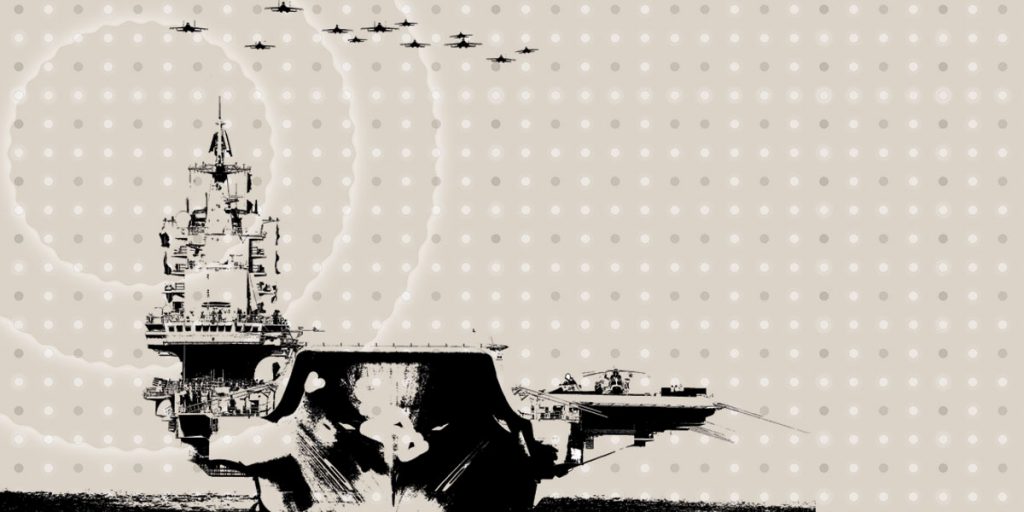
Aircraft carrier Liaoning on display in the maritime parade conducted by the People’s Liberation Army Navy in the South China Sea on the morning of 12 April 2018
Photo: Zhang Lei, eng.chinamil.com.cn
ON 1 AUGUST 2018, the People’s Liberation Army (PLA) celebrated its ninety-first birthday. From its humble beginnings as a peasant army, the PLA has become one of the most powerful armed forces in the world. Under Xi Jinping’s 习近平 watch, the Chinese military has greatly accelerated the drive towards modernisation that started under Deng Xiaoping 邓小平 in 1978. In 2016, the PLA embarked on the most sweeping and radical military reforms in the history of the People’s Republic of China (PRC). Three years on, it is a good time to take stock of both the PLA’s achievements and the challenges it faces in its transformation to a ‘world class’ military.
In early March 2018, at the annual assembly of the National People’s Congress (NPC), China announced that its defence budget would increase by 8.1 per cent, taking total defence spending in 2018 to 1.1 trillion yuan (US$175 billion) — second only to the United States, which would spend US$692 billion in the 2018 fiscal year. Despite China’s weakening economic growth, this was the largest increase in three years, following a rise of 7.5 per cent in 2016 and seven per cent in 2017. In his report to the NPC, Premier Li Keqiang 李克强 stated that ‘faced with profound changes in the national security environment, we must treat the Party’s goal of building stronger armed forces for the New Era as our guide’ and ‘stick to the Chinese path in strengthening our armed forces’ so as to ‘firmly and resolvedly safeguard national sovereignty, security, and development interests’.
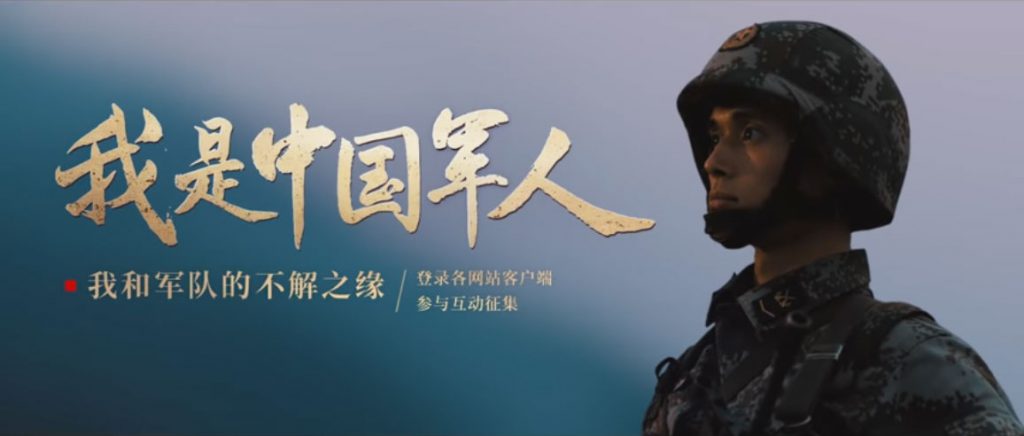
A still from a 2018 recruitment video from the PLA: the main slogan reads ‘I am a Chinese soldier’
Source: YouTube
The NPC meeting also approved the establishment of a new Ministry of Veterans Affairs (MVA) amid an overall downsizing of the Central Government, which saw the number of ministerial-level bodies being cut by eight and vice-ministerial level ones by seven. This overhaul of the Central Government not only sought to improve administrative efficiency, but also reflected shifting policy priorities. For example, in contrast to the establishment of new agencies such as the MVA, the once powerful National Health and Family Planning Commission was dismantled due to the relaxation of China’s population control policy. According to China’s official Xinhua News Agency, the creation of the MVA was intended to ‘protect the legitimate rights and interests of military personnel and their families’ and ‘make military service an occupation that enjoys public respect’. Being a member of the PLA was a socially privileged occupation during the Maoist era, when its soldiers not only enjoyed high social esteem as Party-advocated role models for society, but also had access to preferential welfare benefits and post-service career opportunities that were not available to the ordinary people. However, this changed in the post-Mao reform era. With the marketisation of the Chinese economy providing many new opportunities for social advancement and wealth creation, not only has the social status of military personnel declined significantly, but also the re-employment of demobilised military personnel has become an increasingly challenging social problem, making military service a much less esteemed occupation than before. The creation of the MVA reflects the Chinese government’s unprecedented effort to reverse the trend.
On 12 April, President Xi Jinping personally presided over a massive Chinese naval parade held in the South China Sea — the largest display of naval power in the history of the PRC. The parade involved 48 modern surface and underwater warships; 76 advanced military aircrafts; more than 10,000 troops; and China’s first aircraft carrier battle group, the Liaoning. Xi delivered a speech after the parade, declaring that ‘in the course of the struggle for the great rejuvenation of the Chinese nation, we have never had such a pressing need to build a strong navy’. Official Chinese media reported that more than half of the modern warships displayed in the parade had come into service since 2012, when Xi first became Party chairman and state president.
The PLA has been engaged in a sustained modernisation program for more than three decades. Since Xi came to power, however, the pace and scope of military modernisation has intensified and broadened substantially. Seeing a ‘strong military dream’ 强军梦 as an indispensable part of his ‘China Dream’ 中国梦 of national rejuvenation, Xi has made strengthening China’s military power a top policy priority.
‘A New Historical Starting Point’
On 24 November 2015, at a three-day Central Military Commission (CMC) working conference on military reform, Xi announced the most radical and comprehensive reform program of the PLA since 1949, asserting that ‘with China currently being at the crucial stage of progressing from a large country to a strong power, the building of national defence and the military is at a new historical starting point’.
Following Xi’s announcement, on 1 January 2016, the CMC released its ‘Opinion on Deepening National Defence and Military Reform’《关于深化国防和军队改革的意见》. It stated that the new reform program sought to remove the ‘institutional obstacles, structural contradictions and policy problems’ that had thwarted the development of China’s national defence and military power. Central to the reform is modernising the PLA’s organisational structure to ‘further unleash its combat effectiveness’.
The agenda for reform in the Opinion covered almost every aspect of PLA affairs, including: the military leadership system; joint operations command structure; the scale, structure, and composition of the military forces; military training, education, and recruitment; policy; integration of civilian and military defence R&D and industry; restructuring the People’s Armed Police; and the military legal system. The Opinion demanded that, by 2020, the PLA should make ‘breakthrough progress’ in restructuring its leadership system and joint operations command system, and achieve ‘significant progress’ in optimising the scale and structure of its forces, improving its system of policy-making, and deepening civil–military integration.
The fundamental goal of the reform program, as stated in the CMC’s Opinion, is to build a strong national defence and a powerful military, compatible with China’s international status and national security and development interests, so as to provide ‘rock-solid power guarantee’ for the ‘realisation of the two centenary goals and the China Dream of the great rejuvenation of the Chinese nation’. Inspecting a military parade on 30 July 2017 — the day before the PLA’s ninetieth anniversary — Xi declared that: ‘Today, we are closer to the goal of the great rejuvenation of the Chinese nation than any other time in history, and we need to build a strong people’s military more than any other time in history’.
The importance of military modernisation was further highlighted in Xi’s Nineteenth Party Congress report in 2017, in which he devoted a full section to the subject of military reform and national defence modernisation. Urging that the military ‘must be up to shouldering the missions and tasks of the New Era entrusted to them by the Party and the people’, Xi announced that the PLA should complete mechanisation and make major progress in informationisation by 2020, achieve basic completion of the modernisation of the national defence and armed forces by 2035, and be ‘fully transformed’ into a ‘world-class’ military by the middle of the twenty-first century.
To Fight and Win
The reforms implemented under Xi Jinping have achieved fundamental, even revolutionary, changes to systems in place for nearly seven decades. Most significant of these has been the complete overhaul of the PLA’s leadership system at the top level. Under what was dubbed ‘above-the-neck’ 脖子以上 reform, four previously powerful, colossal CMC General Departments — the General Staff Department, General Political Department, General Logistics Department, and General Armaments Department — were dissolved and replaced by fifteen smaller but more functionally specific departments, commissions, and offices.
The restructuring concentrates power in the CMC itself and, in particular, its chairman — Xi himself. The powerful and clumsy departments had previously run PLA affairs in an increasingly and, to the top brass, unacceptably autonomous manner. Under the new arrangement, the CMC and its chairman take more direct charge of PLA affairs. The dissolved departments were also largely army-dominated institutions unsuitable for guiding modern joint operations. This is most clearly illustrated by the replacement of the General Staff Department, which was primarily an army institution, with a new CMC Joint Staff Department 联合参谋部, which consists of staff from all services.
The second major radical change is the establishment of a two-level joint combat operation command system befitting the needs of modern warfare. At the regional level, five new joint Theatre Commands (TCs) replace seven Military Regions (MRs). The Central, Northern, Eastern, Southern, and Western TCs will command joint combat operations during wartime in their geographic areas. There are two critical differences between the new TCs and the old MRs. First, while the MRs were largely in charge of army units, with little authority over other services, the TCs enjoy absolute operational command over all services within their jurisdictions. Second, whereas the MRs had wide-ranging administrative responsibilities including military training and force development, the TCs’s sole responsibility is to command joint operations in combat, leaving force building and other administrative duties to the respective services.
At the central level, a new CMC Joint Operations Command Centre now acts as the highest commanding authority of the PLA operations, both at war and during peacetime. Xi himself holds the position of the Commander-in-Chief of the Joint Operations Command Centre, supported by the newly established Joint Staff Department.
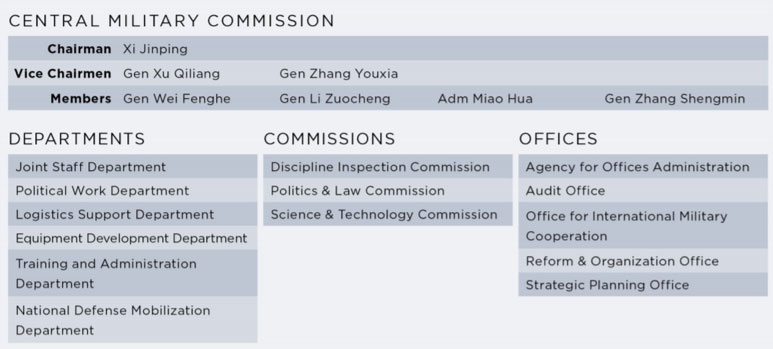
China’s military leadership
Source: Annual Report to Congress: Military and Security Developments involving the PRC 2018, Office of the Secretary of Defense, USA, p.4.
The reforms have also fundamentally changed the roles of individual PLA services. The services are now essentially administrative, focussing on peacetime force development, training, and capability building. In 2018, the PLA had a new command and control system defined by the principle of ‘the Central Military Commission in charge of overall military affairs, Theatre Commands in charge of wartime joint operations, and services in charge of force development’ 军委管总, 战区主战, 军种主建.
Lean and Powerful
In addition to the radical restructuring discussed above, the last three years have seen significant changes made to the scale and structure of the Chinese military. The goal is to transform the PLA from a military of quantity to one of quality, and from a manpower-intensive to a technology-intensive military.
These changes move the PLA further away from the ‘Big Army’ 大陆军 mentality inherited from the Maoist era, which has been dominant since 1949. The establishment of a separate PLA Army headquarters brings the Army into equal status with other services. The Second Artillery Corps (China’s missile and nuclear force), meanwhile, has risen to the status of an independent service — the PLA Rocket Force — which stands alongside the Army, Navy, and Air Force. A new Strategic Support Force (with a service-equivalent status, though not formally a separate service) provides integrated cyberspace, space, and electronic-magnetic warfare support for joint operations. Finally, the newly established Joint Logistics Support Force will provide efficient, central coordination covering the previously fragmented service and military region-based logistical support systems.
The PLA has also demobilised 300,000 personnel since 2016 — reducing the number of troops and personnel from 2.3 million to two million — mostly from the ground forces. In 2018, for the first time since 1949, the army’s share in the PLA has dropped below fifty per cent, while those of the Navy, Air Force, and Rocket Force have expanded. This reflects the CMC’s assessment of China’s changing security environment; the increasing importance of the maritime, space, and cyber domains in (possible) future wars; and the need to defend China’s expanding overseas interests.
China’s last Defence White Paper, in 2015, called on the PLA to abandon its ‘traditional mentality’ of attaching more importance to land than sea, noting that ‘great importance has to be attached to managing the seas and oceans and protecting maritime rights and interests’. It stated explicitly that ‘in line with the evolving form of war and national security situation’, China would focus on preparing to win ‘informationised local wars’ and ‘maritime military struggles’.
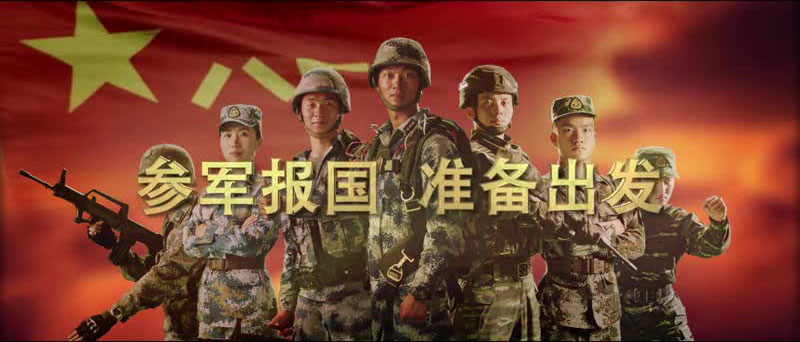
Still from a 2018 PLA recruitment promotional video: the slogan reads ‘Join the army and protect the country, prepare to go out and fight’
Source: 81.cn
The reduction in forces also reduces the proportion of non-combat personnel through the amalgamation and dissolution of various administrative agencies, military arts and cultural units, and educational institutions. Significantly, the reform also demands that by the end of 2018 the PLA should stop all so-called ‘Paid for Services’ 有偿服务 provided to the general public. The PLA entered into the business sector when China’s economic reforms started in 1978, in part driven by the low defence budget at the time. However, in 1998, under then Chinese leader, Jiang Zemin 江泽民, the military was banned from most of its business activities, due to grave concerns of rampant corruption associated with those activities. However, military-run institutions such as hospitals, schools, hotels, publishing-houses, and cultural and sports units, have been allowed to continue to provide some fifteen types of Paid for Services to the general public. The latest reforms push for a complete divesture of the PLA from any of these remaining commercial activities, with the dual aims of focussing the military’s attention on improving its fighting capability and preventing corruption.
Still under Party Command
While improving the PLA’s combat capability for contemporary warfare has been a top priority over the last three years, for Xi Jinping, strengthening the Party’s and his own personal control over the military is an equal, if not more important agenda. The Party (not the state) has commanded the military since the Red Army days. (The Chinese Workers’ and Peasants’ Red Army was founded in 1927; the ‘Red Army’ was formally renamed the People’s Liberation Army in 1948 during the Party-led war to liberate the country from the ‘anti-revolution’ nationalist government.) Modernisation and reform have not changed this fact: the PLA’s first and foremost mission is to serve the interests of the Party. The latest military reforms under Xi take this to a whole new level.
In his report to the Nineteenth Party Congress, beyond talking about building the PLA into a world-class military, Xi also stressed the importance of strengthening the Party’s work within the PLA. He instructed the PLA to carry out a political education program focussed on ‘passing on the red gene’ 传承红色基因. In June 2018, the CMC released the ‘Guideline on Implementing the Program of Passing on Red Gene’, describing it as a ‘strategic task’ for the New Era. The Guideline asserted that the education program should focus on ‘forcefully building [the PLA’s] absolute loyalty with regard to safeguarding the Core of the Party [Xi Jinping] and obeying the Party’s commands’.
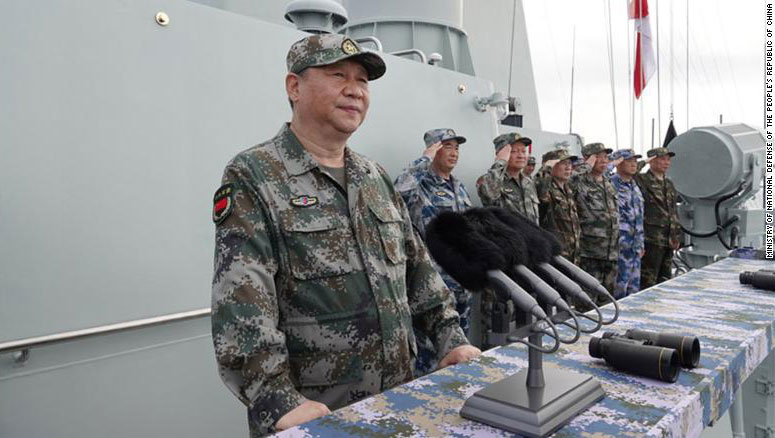
Xi Jinping reviews a naval parade in the South China Sea, April 2018
Source: Ministry of National Defense of the People’s Republic of China
The reforms since 2016 have substantially strengthened Xi’s personal control over the military by placing unprecedented emphasis on the CMC Chairman Responsibility System 军委主席负责制. The system has been in place since 1982, when Deng Xiaoping held the position, and has been enforced to various degrees under different leaders since then. In particular, under Xi’s predecessor, Hu Jintao 胡锦涛, senior military leaders such as former deputy CMC chairmen Guo Boxiong 郭伯雄 and Xu Caihou 徐才厚 enjoyed a high degree of autonomy, largely making the position of CMC chairman that of nominal Commander-in-Chief. Since 2016, Xi Jinping has emphatically enforced the Chairman’s Responsibility System as a central element of the reform, giving himself direct control over military affairs.
Writing in the PLA Daily in 2016, Lieutenant General Fan Xiaojun 范骁骏, who would become Political Commissar of the Northern Theatre Command in 2017, asserted that for the PLA, the unreserved implementation of the CMC Chairman’s Responsibility System represented the ‘greatest loyalty, the most pressing political task and most unbending iron discipline’. In February 2018, the CMC distributed ‘A Reader on the CMC Chairman Responsibility System’ to the whole PLA, asking all members, and especially the senior military leaders, to deepen their awareness of the System and implement it unswervingly.
The reforms have also introduced other new institutional measures to strengthen the Party’s control over the military. These include the elevation of the status of the CMC’s Discipline Inspection Commission 军委纪律检查委员会. The chief of the Commission is now a member of the powerful CMC, with a status higher than that of the service chiefs and heads of most CMC departments. The move was intended to strengthen the Party’s ability to combat rampant corruption within the military. In late 2017, the Commission’s investigations led to the removal of two of the most senior PLA officers from their positions (Fang Fenghui 房峰辉, founding chief of the CMC’s Joint Staff Department, and Zhang Yang 张阳, founding chief of the CMC’s Political Work Department 军委政治工作部), due to corruption charges. Zhang reportedly committed suicide during the investigation.
Challenges Ahead
Three years after Xi’s announcement of the most radical military reform program in the PRC’s history, the PLA has undergone a revolutionary transformation. Given the nature, scale, and speed of the changes, it is not surprising that by the middle of 2017 Xi praised the reforms for taking ‘historical steps’, making a ‘historical breakthrough’; and achieving ‘historical accomplishments’. Xi’s personal involvement and firm resolve in the process has undoubtedly been critical to the radical transformation of the PLA.
The PLA still must overcome enormous hurdles to become a truly world class military on par with that of the United States. Despite decades of efforts to modernise, it still substantially lags behind its US counterpart in military technology, combat capabilities, overseas reach, and military alliance networks, among other things. The PLA has not engaged in a major conflict since the Sino-Vietnam border war in 1979, and lacks experience of modern joint operations in combat. While the organisational changes are impressive, the efficacy and effectiveness of the new PLA Command and Control system remains untested.
But China’s current military power matters less than its potential for growth and the country’s ambitions. For one thing, while the US currently outspends China on defence by a big margin, Australia’s 2016 Defence White Paper forecast that by 2035, China would be the world’s biggest spender on defence. Whether or not this comes to pass, the modernisation of the military is sure to remain a top priority for the Chinese leadership for decades to come. This is because, for the Chinese leadership under Xi, a strong military is not just a means to ensure China’s rise, but an end in itself that symbolises China’s advance to the centre of the world stage.
Notes
For the full text of the report, see http://en.people.cn/n3/2018/0403/c90000-9445262-3.html
‘China to form ministry of veterans affairs’, Xinhuanet, 13 March 2018, online at: http://www.xinhuanet.com/english/2018-03/13/c_137035510.htm
‘The Central Military Commission Held the Naval Parade in the South China Sea’ 中央军委在南海 海域举行海上阅兵, China Military, 12 April 2018, online at: http://www.81.cn/jwzb/2018-04/12/content_8002364.htm
‘Xi Jinping: Comprehensively implementing the strategy of reform and military building, Firmly walking on the Path of Military Building with Chinese Characteristics’ 习近平:全面实施改革强 军战略 坚定不移走中国特色强军之路, Xinhuanet, 26 November 2015, online at: http://www.xinhuanet.com//politics/2015-11/26/c_1117274869.htm
The two centenary goals are for China to become ‘a moderately prosperous society in all respects’ by 2021 (the Party’s centenary), and ‘a modern socialist country that is prosperous, strong, democratic, culturally advanced and harmonious’ by 2049 (the PRC’s centenary).
‘The Central Military Commission Released Opinion on Deepening National Defence and Military Reform’ 中央军委印发《关于深化国防和军队改革的意见》, Ministry of National Defense of the People’s Republic of China, 1 January 2016, online at: http://www.mod.gov.cn/auth/2016-01/01/content_4635557.htm
‘PLA’s 91st Anniversary: Xi Jinping’s Call for A strong Army’, 31 July 2018, China Military (quoting CGTN.com), online at: http://eng.chinamil.com.cn/view/2018-07/31/content_9237734.htm
For a full text of the report, see http://www.chinadaily.com.cn/china/19thcpcnationalcongress/2017-11/04/content_34115212.htm
For the full text of the White Paper, see http://english.gov.cn/archive/white_paper/2015/05/27/content_281475115610833.htm
‘The Central Military Commission publishes “Guideline on Implementing the Program of Pass- ing on Red Gene”’ 中央军委印发《传承红色基因实施纲要》, China Military, 18 June 2018, online at: http://www.81.cn/jwzb/2018-06/18/content_8070294.htm
Fan Xiaojun 范骁骏, ‘Contentiously Pushing Forward the Effective Implementation of the ‘Strict Self-Governance of the Party in Every Aspect’ to Achieve Real Impact’ 不断推动全面从严 治党落地见效, Qiushi Journal, 5 November 2016, online at: http://www.qstheory.cn/zhuanqu/zywz/2016-11/15/c_1119911937.htm
‘Xi Jinping: Under the Support of the Whole Party and Nation, the Military Makes Fullest Efforts to Push Forward Further Reform of National Defence and Military’ 习近平:军队全力以赴全党全 国大力支持 推动国防和军队改革向纵深发展, Xinhuanet, 25 July 2017, online at: http://www.xinhuanet.com/politics/2017-07/25/c_1121378526.htm



